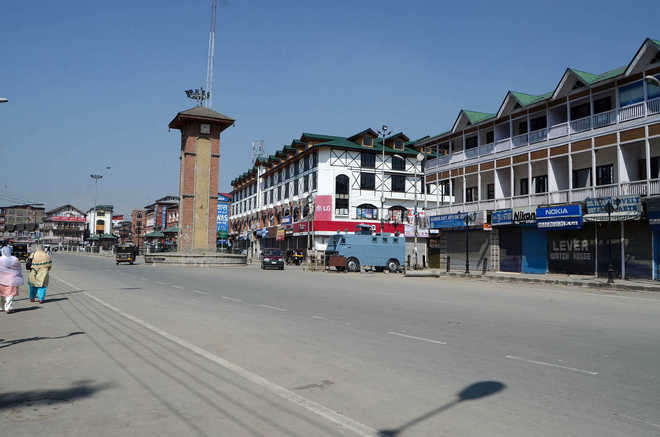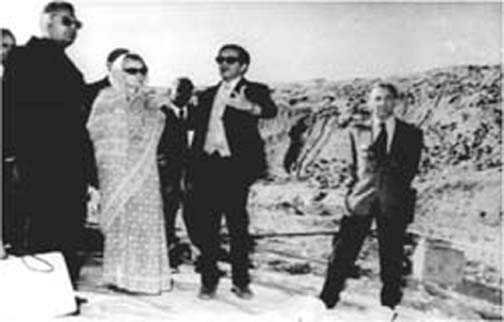
The city centre Lal Chowk in Srinagar wore a deserted look on Thursday. Tribune Photo: Amin War
Ishfaq Tantry
Tribune News Service
Srinagar, May 26
Life in the Valley was affected today due a joint shutdown call given by various separatist organisations against the alleged government proposal to set up Sainik colonies and townships for migrant Kashmiri Pandits.The rare joint call was issued by the moderate faction of the Hurriyat Conference led by Mirwaiz Umar Farooq, hardline faction of the Hurriyat Conference headed by Syed Ali Geelani and Jammu Kashmir Liberation Front chairman Yasin Malik.Shops and other commercial establishments in Srinagar and other major towns across the Valley remained closed today in response to the shutdown. The day, however, passed off peacefully.Public transport remained off the roads, though private vehicles were seen plying on the city outskirts.Roads and commercial centres such as Lal Chowk in the city wore a deserted look.Most of the schools and banks in Srinagar and other towns remained closed.However, there was some movement in tourist areas such as the boulevard road along the Dal Lake in the morning as some tourists were seen departing or heading to other tourist destinations.Some vehicular movement was also seen on the main road leading to the secretariat and government vehicles were seen ferrying ministers and MLAs as the Assembly was in session today.There was less security on city roads today as compared to earlier shutdowns. The government had not imposed any restrictions, however, senior separatist leaders Geelani and Mirwaiz were put under house detention. JKLF chairman Yasin Malik was arrested from the Abi Guzar area of Srinagar on Wednesday.Even as the PDP-BJP government has already clarified its stand on the Sainik colonies and townships for migrant Pandits and also promised a review of the new industrial policy, the issues have united the separatists and brought them on a single platform against the state government. The separatist have vowed to oppose the proposal tooth and nail.Though the state government has said it was committed to the return of Kashmiri Pandits, separatists have opposed the establishment of separate townships in the Valley for their rehabilitation.While the government has said it has not identified any land for setting up Sainik colonies for retired soldiers of the state, separatists alleged the intention behind setting up Sainik colonies was to change the demography of the Valley.Moreover, the government has asserted that non-local ex-serviceman cannot become part of any Sainik colony in Kashmir as only permanent residents of the state can purchase land in such settlements.Tourists head to hill resortsMost of the tourists in Srinagar preferred to proceed to hill resorts of Gulmarg, Pahalgam and Sonamarg due to a shutdown in city. Tourist cabs were on Thursday morning seen heading to hill resorts where the shutdowns usually have less effect. “I left for Pahalgam on Thursday morning. The tourist party is from Delhi. Since there was a strike in Srinagar, they decided to visit Pahalgam as they are on a short visit to the Valley,” said Ali Mohammad, a taxi driver from Srinagar.
No restrictions
- Schools, banks and shops in Srinagar and other major towns of the Valley remained closed on Thursday
- There was less security on city roads today as compared to earlier shutdowns. The government had not imposed any restrictions
Army orders probe into porter’s death
Tribune News Service
Srinagar, May 26
The Army has ordered an inquiry into the death of a porter from Handwara accompanying them, who was found injured after the troops came under fire from suspected militants in a forest area early on Wednesday.“An inquiry has been instituted to establish in detail the possible circumstances leading to the death of Liaquat Ali. Since the deceased was working with the Army, we are committed to providing all possible assistance,” an Army spokesman said.The statement said a joint search operation was launched by the Army and J&K Police in the area of the Watsar forest on Tuesday night. Liaquat of Nagni Wadar Payeen village, who has been working as a porter with the Army, accompanied the search party.“After a brief exchange of fire, the area was searched during which Liaqat was found injured,” he added.






























































